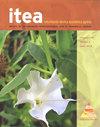Materiales porosos como soporte de viabilidad de Beauveria bassiana para el biocontrol de Sphenarium purpurascens in vitro
IF 0.4
4区 农林科学
Q4 AGRICULTURE, DAIRY & ANIMAL SCIENCE
引用次数: 0
Abstract
Entomopathogenic fungi are a large group of micro-organisms that provide multiple services to agroecological systems and have some advantages over chemical insecticides, since they produce mortality rates naturally and have less environmental impact. The production of biocontrol agents such as Beauveria bassiana finds multiple limitations, such as the adjustment of the optimum concentration of conidia and specific speed of death, among others. In addition, the potential that Mexican native strains can have for their use in the control of the grasshopper Sphenarium purpurascens (an edible insect but that behaves as a pest in several crops). In the present investigation, the mortality of two instars (or stages) of S. purpurascens in vitro plus the adult phase, was evaluated by applying bio-preparations of the MA-Bb1 strain in porous materials as support. The highest corrected mortality CM% and the highest specific speed of death K(d–1) of the orthopter for the different instants, as well as for the adult of S. purpurascens was presented in the bio-preparation (Zeolite + Diatomite + B. bassiana) at a concentration of 1 × 108 conidia mL–1, presenting a viability of 89,1%. These results show the possibility for biocontrol with the use of the native Mexican strain MA-Bb1 of B. bassiana in combination with porous materials of diatomite and zeolite, in laboratory conditions.多孔材料作为球孢白僵菌活力的载体,用于紫球藻的体外生物防治
昆虫病原真菌是一大类微生物,为农业生态系统提供多种服务,与化学杀虫剂相比具有一些优势,因为它们自然产生死亡率,对环境的影响较小。白僵菌等生物防治剂的生产存在多种局限性,如分生孢子的最佳浓度和特定死亡速度的调整等。此外,墨西哥本土菌株在控制蚱蜢(一种可食用昆虫,但在几种作物中表现为害虫)方面的潜力。在本研究中,通过在多孔材料中应用MA-Bb1菌株的生物制剂作为支持物,评估了两龄(或两个阶段)的S.purpurascens在体外加成体期的死亡率。在生物制剂(沸石+硅藻土+球孢菌)中,在1×108分生孢子mL–1的浓度下,不同时刻以及紫色葡萄球菌成虫的矫正死亡率CM%和死亡率K(d–1)最高,生存率为89.1%。这些结果表明,在实验室条件下,使用球孢菌的墨西哥本土菌株MA-Bb1与硅藻土和沸石的多孔材料相结合进行生物防治的可能性。
本文章由计算机程序翻译,如有差异,请以英文原文为准。
求助全文
约1分钟内获得全文
求助全文
来源期刊

Itea-Informacion Tecnica Economica Agraria
农林科学-农业经济与政策
CiteScore
0.90
自引率
0.00%
发文量
15
审稿时长
>12 weeks
期刊介绍:
ITEA publica artículos que hagan referencia a los distintos aspectos de las ciencias agro‑alimentarias, cuyo contenido sean resultados obtenidos, descripción de métodos, técnicas o materiales, presentación de nuevas ideas, etc.
 求助内容:
求助内容: 应助结果提醒方式:
应助结果提醒方式:


